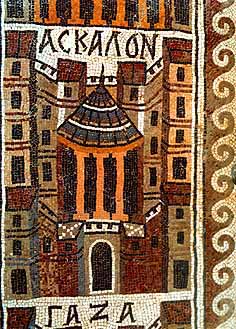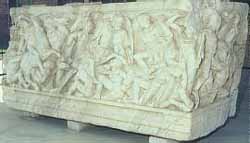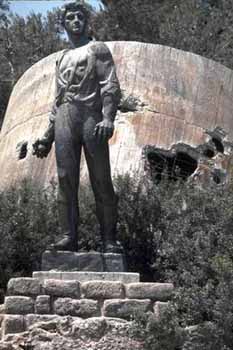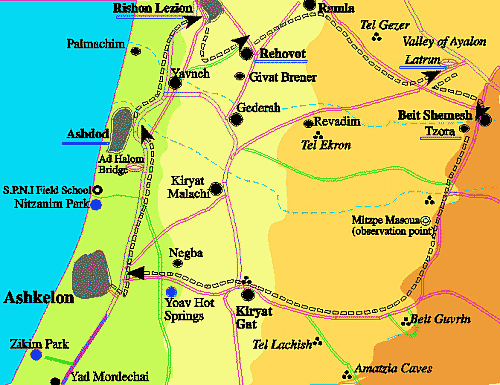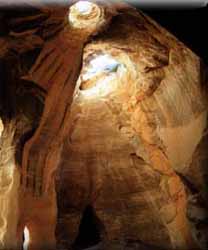Ashkelon & Surroundings
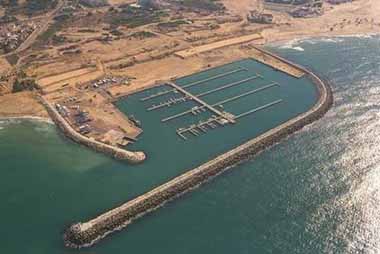 |
AshkelonIsrael has one of the world's most beautiful coastlines, with white sandy beaches and spectacular Mediterranean views. The coast stretches to the northern border with Lebanon at Rosh Hanikra and south to the Gaza Strip. Just north of Gaza and 36 miles south of Tel Aviv is the southernmost stop for most tourists, the city of Ashkelon.
Like so many other places in Israel, Ashkelon is built upon the ruins of past civilizations. This was one of five Philistine city-states (along with Gath, Gaza, Ekron and Ashdod). The city also plays a role in biblical history as the place where Delilah cut Samson's hair to sap his strength (Judges XIV-XVI). Ashkelon was also a great trading center because it lay along the Via Maris, the route linking Egypt with Syria and Mesopotamia. The city was first settled at the end of the third millennium B.C.E. It was conquered by the Philistines in the second half of the 12th century. After the Israelite conquest of the rest of the area, the two peoples engaged in several hundred years of conflict. After King Saul was slain by the Philistines, David lamented:
Even after David defeated the Philistines in much of the rest of the country, he could not dislodge them from Ashkelon. This was finally accomplished by the Assyrian conqueror Tiglath-Pileser III in 734 B.C.E. After roughly 600 years in the region, the Philistines disappeared forever.
The city passed through the hands of the region's subsequent invaders before enjoying a renaissance under the Greeks and Romans. After the Jews, under the leadership of the Maccabeans, overthrew the Greeks in the 2nd century, Ashkelon became an autonomous city. It is believed that Ashkelon was the birthplace of Herod (in 37 B.C.E.), who enlarged and beautified the city, constructing a summer house, palaces and an aqueduct. Under the Romans, Ashkelon was also granted the rare privilege of being exempt from taxes. It became a flourishing trade center and, in particular, a major wine producer. The city became a Christian city in the Byzantine period and was captured by the Muslims in 638 C.E. The Crusaders came next in 1153, but were defeated by Saladin. Richard the Lion Heart led the Crusaders back, but they were eventually driven out in 1280 by Sultan Baybars. The city was then abandoned until 1948 when the Jews of the new State of Israel began to rebuild it. Ashkelon was reestablished as an Israeli city in 1953.
Today, Ashkelon is enjoying a growth spurt, fueled in part by immigrants from the former Soviet Union. The population is now roughly 90,000. This is primarily a place to hit the beach, though some interesting archaeological ruins are continuing to be unearthed. These include a Byzantine church, a Roman tomb and one of the oldest arched gateways in the world. One of the most notable recent finds is a bronze and silver calf that is more than 3,500 years old and may be distantly related to the biblical tale of the golden calf. The National ParkThis is the site in Ashkelon of the ancient cities. It is located on the southern coast of modern Ashkelon. From the entrance, the road passes through the 12th century Crusader city walls and the Canaanite earth ramparts. There are several ongoing excavation sites near the sea, which reveal the city's biblical roots. One of the most intriguing sections of the Park is the sculpture garden, in which many Roman statues stand. There are also several ruins of Byzantine and Crusader churches nestled within the Park. Yad Mordechai
Just south of Ashkelon is Kibbutz Yad Mordechai, which was founded in 1943 and named after Mordechai Anilewicz, the leader of the Warsaw Ghetto uprising. A giant statue of the hero overlooks the community. Behind it is the Kibbutz's old water tower that was shelled by the Egyptians during the 1948 War. The kibbutz has a museum dedicated to the ghetto fighters. It also has its own exciting history because it was on the frontline during the War of Independence in 1948 and was captured and destroyed by the Egyptians. The kibbutz was subsequently recaptured and rebuilt. The kibbutz also has reconstructed a scene from the war with life-size cut-outs with rifles and helmets representing the Egyptians. Ashdod
Back along the coastal road toward Tel Aviv is another of the major Philistine cities, Ashdod. It was the Philistines who made the mistake of taking the Ark of the Covenant (I Samuel 5, 1-6) and bringing it to Ashdod. Afterward, the community was struck by a number of calamities that led the Philistines to return the Ark to the Israelites. About four miles south of the present city is Tel Ashdod, the site of the biblical city that was first mentioned in the Tanakh as one of the cities allocated to the tribe of Judah (Joshua 15:47). Ashdod was an important city because of its location along the coastal route leading from Egypt to Syria and Mesopotamia. Ashdod also has significance to Christians because Philip the Evangelist (or the Deacon) received "the call" to go into the desert and preach to a eunuch, a minister of the queen of Ethiopia. Philip converted and baptized the man and returned along the coast through Ashdod where he preached to its citizens (Acts 8). At the southern entrance of the city is a bridge where the fledgling Israeli army stopped the Egyptian Army's advance toward Tel Aviv in the 1948 War. It was founded by the Jews in 1957, and has been rapidly developing since. Today, Ashdod is a thriving city of 150,000 people, which has surpassed Haifa as Israel's busiest port, which was constructed in 1966. Ashdod's two power plants also supply roughly half of Israel's electricity. Rishon LezionFurther north is Rishon Lezion, a town founded in 1882 by Russian immigrants that has grown into one of Israel's principal wine centers. Baron Edmond de Rothschild provided funding that helped establish the wine industry. Free guided tours are available at the wineries. This is also where the first kindergarten and elementary schools were founded.
RehovotTraveling inland not far from Rishon Lezion is Rehovot, the home of the Weizmann Institute of Science. The university was dedicated in 1949 in honor of Chaim Weizmann, Israel's first president, who actually founded the institution as the Sieff Institute in 1934. Dr. Weizmann, who was a renowned chemist himself, and his wife had a home on the campus as well, which is now open to the public. Weizmann's tomb is also nearby. Rehovot is also home to the Ayalon Institute Museum. This was an underground munitions factory used during the mandatory period. Kiryat GatA rapidly growing town 15 miles east of Ashkelon, Kiryat Gat is near the tel believed to be the site of Gath, one of the five important Philistine cities and the birthplace of Goliath. LachishThe town of Lachish 20 miles east of Ashkelon may have first been inhabited 5,000 years ago. It is first mentioned in the Bible when Joshua killed all the people and hung its king (Joshua 10:22-32). King David developed the city and his grandson Rehoboam fortified it. In the 6th century B.C.E., however, the Babylonian conqueror Nebuchadnezzar destroyed the city. When Jews returned after their Babylonian exile, they rebuilt the city. It was abandoned again, however, after the destruction of the Second Temple in 70 C.E. and was never resettled. Beit Guvrin
When Maresha fell in the 1st century BC, the nearby city of Beit Guvrin became an important regional center. An ancient city 24 miles east of Ashkelon. The city was at the center of the largest region in Palestine during the Roman occupation and was enlarged and fortified by the Roman Emperor Septimus Severus. It was conquered by the Crusaders who built a citadel. Saladin destroyed the city. Evidence of Jewish life is the 3rd century synagogue ruins. The ornate Sidonian tombs are testaments to the affluence of the 3rd and 4th century inhabitants. Not far from the Crusader ruins are a series of enormous limestone caves, some of the 800 in Beit Guvrin, dating back to the Hellenistic times. The caves were used as water cisterns, animal pens, burial, raising pigeons, oil industry and, more recently, as one of the sets for the film Rambo III. Some caves were also used as churches and you can still see crosses carved on the walls. Ongoing excavations are uncovering a Roman amphitheater near the entrance to Kibbutz Beit Guvrin.
Also nearby is Tel Maresha, another hill fortified by Rehoboam. An interesting historical fact is that when the Hasmonean ruler, John Hyrcanus, captured the area in 125 B.C.E., he forcibly converted the Idumean population to Judaism to ensure their loyalty. Referring to Beit Guvrin as a “microcosm of the land of the caves,” the UN Educational, Scientific and Cultural Organization (UNESCO) designated the Beit Guvrin National Park as a UNESCO World Heritage site in April 2015. Beit Guvrin joined Masada, the Old City of Acre, the Baha'i holy places, and four others as designated UNESCO World Heritage sites in Israel AmatziaAnother series of caves are in Amatzia, a small park east of Ashkelon and south of Beit Guvrin. The complex of caves was used by Jewish rebels during the Bar-Kokhba Revolt in the 2nd century. Approximately 300 people lived in the cavern's 35 rooms. The restored complex includes an underground synagogue, a guard room, water cisterns, store rooms, an oil press and secret hideaways. Tel EkronNortheast of Ashkelon is another of the five great Philistine cities, Ekron. The city was founded in the twelfth century B.C.; first mentioned in the Bible in Joshua 13:2-3. Under Assyrian rule, Ekron became the largest olive-oil production center in the ancient Near East. More than 100 oil presses were found here. It supplied the Egyptian and Assyrian Empire with as much as 700 tons of oil a year. Artifacts from the Philistine period and a reconstructed Philistine street are in nearby Kibbutz Revadim. |
| Previous | Next |

